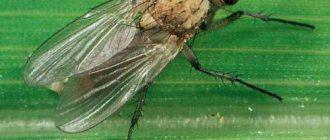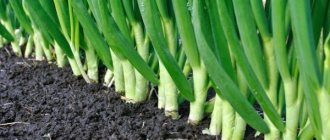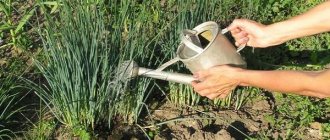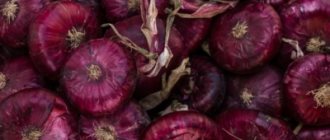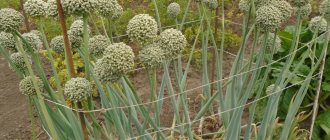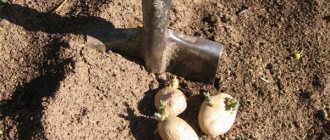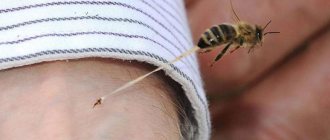Almost everyone loves onions. Wanting to get larger heads or green vitamin feathers for your table as early as possible, it is planted in a well-lit place, in loose soil with a slightly alkaline reaction. But compliance with the rules of crop rotation requires seasonal rotation of crops. Therefore, after onions, you need to plant vegetables that have similar requirements for soil composition, acidity level, light and watering. After all, leaving the garden bed completely empty, “fallow”, after harvesting is impractical, even if the size of the plot allows it.
The structure of bare soil will be damaged due to constant exposure to sunlight, rain and wind in the complete absence of vegetation.
When constantly busy, the soil needs temporary rest from plants of the Onion family. There are important reasons why certain plants cannot be planted immediately after onions next year in open ground.
You can find useful information about leeks, leeks, and other various types and popular varieties of onions in the section of our website.
Is it possible to plant onions after onions?
Proper crop rotation when planting onions - after harvesting, the bed should rest for 3 years before the same crop is replanted on it. Causes:
- soil fatigue;
- common pathogens and pests.
Each plant selects from the soil those elements and substances that are necessary for its growth and maturation. If you plant onions after onions, the soil is significantly depleted, and even the richest fertilizers will not replenish the reserves of useful components that onions “suck” from the soil.
Visually, this can be determined by the fact that the yield in the beds becomes lower, and the bulbs themselves become smaller, their taste deteriorates and the content of nutrients decreases. This phenomenon is called soil fatigue.
Onions, like all crops, have their own pests and diseases:
- downy mildew;
- fusarium rot;
- pink root rot;
- onion fly;
- onion thrips, etc.
Pathogens and pest larvae overwinter in the soil (they remain there in small quantities even after the most correct treatment for the winter) and wait for “their host” - a crop on which they can feed and reproduce. When sowing onions annually in the same bed, the mass of harmful microflora will rapidly approach critical.
Preparing the soil before planting other crops
Thoughtful preparation for the next agricultural cycle helps create favorable conditions for growing other crops. After the autumn harvest of a demanding vegetable, complex compounds must be added to the open ground beds to replenish the deficiency of substances consumed by it. Fertilizers containing the main mineral components are applied in advance, in accordance with the recommended timing and strictly in the dosages indicated on the package.
Organic fertilizers of natural origin (chicken manure, cow manure, compost) are no less important. Even annoying weeds (comfrey, nettle, dandelion, burdock) will serve as a means to increase soil fertility if you prepare herbal infusions from them.
It is worth considering that any applied fertilizers do not begin to work immediately, while both a deficiency and an excess of elements negatively affect the development of plants
Despite the fact that onion infusions are often used when growing various vegetable crops as a means of prevention against pathogenic microorganisms and protection against pests, in practice its juicy heads and green feathers are also exposed to misfortune. During the entire active growing season, a plant may suffer from common fungal infections: peronospora (downy mildew), Alternaria, Fusarium, rust, various rot and viral diseases, which usually appear when agrotechnical requirements are not met.
Hoverflies and onion flies are considered specific pests for all bulbous plants, methods of combating which are described in detail in the article on our website.
Onion mites and nematodes living on fibrous root systems are difficult to detect visually due to their microscopic size
Beds with onions also attract rodents, which do not go far from their food supply unless they are driven away by force. You can get rid of burrowing inhabitants of the garden in various ways: using traps, repellers. If you decide to take the drastic route and use chemical poisons to protect the crop from unwanted “freeloaders”, make sure that children, pets and birds cannot reach the baits.
What to plant after onions next year?
They grow well in beds where onions were planted a year earlier:
- pumpkin (cucumber, pumpkin, zucchini, squash, zucchini, and melon);
- legumes (beans, peas, chickpeas (peas), soybeans);
- nightshades (tomatoes, potatoes, hot peppers, sweet peppers);
- root vegetables: carrots, turnips and beets.
These garden crops are immune to onion pests and diseases, and the composition of the soil after onions satisfies all the nutritional needs of these plants. But this does not relieve gardeners from the need to treat the soil from weeds after harvesting and before planting and to feed the crops with fertilizers, both organic and mineral.
And immunity to onion pests does not mean that the plant will automatically not suffer from its characteristic “sores.” Therefore, no one canceled pest control.
It is interesting that legumes and turnips, which grow well in areas after onions, do not feel the best when planted next to them.
Another interesting fact concerning not only onions, but also root crops: if a crop with fruit in the ground (root crop, onion) was grown in a garden bed, the crop with fruit on branches (tomatoes, beans, strawberries, peppers) and vines grows well after it ( cucumbers, zucchini, melons).
Vegetable crop rotation scheme: table
Green manure
If mid-season or late-season onions were grown at the dacha, harvesting can begin at the end of August or beginning of September. The period of night frosts will soon begin, so it will not be possible to plant a new crop after the onions are harvested. To saturate the soil with useful substances and establish crop rotation, you can use green manure, which in everyday life is called “green doctors”. Their planting will allow:
- prevent weeds from appearing;
- fertilize the soil;
- fight pest larvae and pathogenic bacteria, which in turn will ensure cleansing and disinfection of the soil;
- carry out good loosening of the soil due to strong roots.
Related article:
Do-it-yourself vegetable garden for lazy people: tips for gardeners
For each site you need to select a specific green manure. This plant is classified into 5 varieties. The cruciferous family saturates the soil with phosphorus, sulfur, and organic matter, and protects plant crops from wireworms, root rot, and nematodes.
The Asteraceae family is a source of complex, difficult to decompose organic fibers. Cereals will help fill the soil with potassium, nitrogen and organic matter. Buckwheat will saturate the soil with the same microelements as cereals.
Important! When choosing green manure for onions, special attention should be paid to the cabbage family.
After what crops can onions be planted?
Planting onions is recommended in those beds where agricultural crops were planted with preliminary soil replenishment, as well as in areas after growing green manure crops (annual grasses, winter wheat, etc.)
But late varieties of onions develop very well where early ripening crops were previously grown.
Features of crop rotation
To grow good onions, you need to study after which crops they feel comfortable on the site. Where and after what can you plant it. Although onions are an unpretentious plant, they get along well with different crops in the garden.
First of all, you need to create comfortable conditions for him. You need to know that onions love the sunny side. The presence of magnesium and phosphorus is important for its growth. These minerals remain in the garden after harvesting:
- cabbage;
- tomatoes;
- eggplant;
- peas;
- zucchini;
- green manure;
- spinach;
- salad;
- celery;
- squash.
As these vegetables ripen, minerals are added to the soil that they do not have time to use up. After these vegetables, the onion receives its nutrients in full.
To obtain a double harvest, after the potato harvest in July, you can plant early-ripening onion varieties. Thus, you can get two crops from one bed.
Studies have shown that onions will grow better after:
- legumes;
- cereals;
- spicy herbs;
- potatoes;
- cabbage
Onions give an excellent harvest in place of buckwheat and clover. But they cannot be grown until fully ripe. They are plowed into the ground green, so the earth is enriched and rests until spring. As a result of this procedure, you can expect a rich harvest next fall.
What is the best time to plant onions?
The best effect on the germination of onions, its health and productivity are those predecessors for which the soil was richly amended for planting. This:
- early varieties of cabbage and other cruciferous vegetables;
- early varieties of potatoes;
- cucumbers;
- tomatoes;
- Bulgarian pepper.
You can take a break and instead of vegetables, sow cereal crops - green manure (rye, wheat), mustard, or marigolds in general: these flowers will not only decorate the site, but also a “doctor” for the soil, for its structure.
- Onions react well to soil where carrots were previously grown.
- By the way, these crops grow well if their beds are adjacent: they destroy each other’s pests. The same applies to dill.
- Onions go well with watercress, basil, mint, and grow well after them.
If we talk about winter onions, then it is best to plant seedlings before winter after cereals, tomatoes, beets, early varieties of cabbage and radishes, and cucumbers.
Planting is carried out if the harvest from the garden bed was collected before the beginning of August: the garden bed should dry out slightly and rest.
What can you plant after tomatoes?
How does crop rotation occur in the field?
Growing bulbs in an open field is not an easy process. Experienced summer residents take into account all the features of this troublesome task, so they soon manage to reap a good harvest.
If you provide the plants with proper care, you can harvest the crops in the fall and plow the field. What to do next depends on the owner of the site. When the task is to sow carrots in open ground, you need to use a cultivator to cut the ridges, plant the planting material and cover the crops with mulch. If beets become the followers of onions, then after plowing the area just needs to be leveled. With the onset of spring, you can start sowing beet seeds.
What can't be planted after onions?
After onions, representatives of the onion family grow poorly:
- leek;
- chives;
- wild garlic;
- leek;
- garlic;
- shallots, etc.
If these crops are planted after onions, they will be extremely unstable to pathogens and pests. Beds in which onion crops have been alternated for more than two years will require 2 years of rest and restoration measures.
It is necessary not only to add humus and organic matter to the soil, but also to use potassium fertilizers and ready-made mixtures. It is also necessary to dig up such beds and get rid of weeds.
The same applies to flowers such as amaryllis, hyacinth, etc. They will not grow well in former onion beds.
Why is it important to follow them?
The main reasons why crop rotation is necessary:
- Proper rotation of crops maintains soil fertility.
- The principle of crop rotation prevents the accumulation of pathogens and insect pests.
- Proper planting of crops helps improve soil health.
Planting the same plant in the same bed for several years will lead to soil depletion . In addition, pathogens characteristic of this crop will intensively develop in it.
Some plants not only do not deplete the soil, but, on the contrary, saturate it with nutrients. These plants include legumes, green manure and winter crops. After them, the soil is rich in nitrogen and other useful compounds.
After what vegetables should onions not be planted?
All representatives of the onion family are bad predecessors for each other, so do not plant onions in former garlic beds, after sowing other types of onions (chives, leeks, shallots) and where flowers of the amaryllis and lily genus were grown.
If onions are of early varieties, you should not make a bed where any vegetables of late varieties were collected in late autumn, even those whose earlier varieties have a beneficial effect on the growing season of onions - for example, late cabbage. In this case, the soil will not have time to recover.
It is not recommended to plant onions in the place where celery and sage grew, as well as asparagus.
Onions grow poorly in soil where the same crop has grown for more than three years. Such soil will need to be fertilized and allowed to rest.
Onions and strawberries
The onion family has its own relationship not only with vegetables, but also with berries. Such a popular garden crop as strawberries (strawberries) is very friendly to all types of onions. These crops can be planted in neighboring beds: they will protect each other. You can plant strawberries after onions.
It is better not to make strawberries as a direct predecessor for onions, but to take a year’s break. Strawberries have deep roots, and after the strawberry bed is dug up, it is better to plant legumes or pumpkins, the same cucumbers and zucchini with their superficial root system. And after these crops have been harvested, onions are planted in nitrogen-enriched soil.
What can be sown in August, after harvesting onions and garlic: video
Onion companion plants
Helpful neighborhood. Many people recommend planting garlic next to strawberries, but onions will also be an excellent neighbor for them. And it also feels good and does not interfere with almost all vegetable crops and herbs.
The exceptions are legumes and sage. For them, onions are a bad neighbor.
What vegetables can be planted nearby?
What soil and conditions do onions need?
Onions like the beds to warm up, so they are planted as seedlings in sunny or slightly shaded areas. The optimal soil for this crop is rich loam, not acidic, moderately moist, with good air permeability. You cannot plant onions:
- in the lowlands;
- in places where groundwater is high (it will rot);
- in cold soil;
- in acidic soil.
The last point can be corrected, but not on the eve of sowing: the acid is removed by liming, and this is done 2 years before planting the onions.
The beds where onions will be sown in the spring are dug up in the fall using a spade, carefully removing weeds and applying fertilizer. For 1 m2 you need:
- 5 kg of compost mass (or manure, but always stale!);
- 1 kg of ash.
Fresh manure as a fertilizer for onions is destructive: you should refrain from planting the crop even in cases where the bed was fertilized with such manure a year earlier. You can use ready-made mineral fertilizers for onions.
Spring reclamation work only involves lightly loosening the bed with a rake; if the soil becomes heavier, you can lightly dig up the top layer. Deep digging will disrupt the soil structure formed over the winter and speed up the evaporation of moisture. In spring, fertilizers are applied at a shallow depth so that the short roots of the onion can easily receive the nutrients they need for nutrition.
Although this is a fairly cold-resistant plant (adult onions tolerate ground frosts down to -5°C), it grows best in the temperature range from 12 to 26°C. Therefore, the optimal time for planting is the first ten days of May. Depending on the variety, the growing season for onions ranges from 3 months to six months.
- In normal warm weather, it is enough to water the onion beds once a week, and weed and loosen them with the same frequency.
- In hot and dry weather, you can do more frequent loosening (2 times a week) so that the soil does not become crusty.
- You need to watch the onion feather: if the tips begin to dry out, additional watering is needed.
- To avoid the accumulation of excess moisture in the soil and rotting of the roots, take a closer look at the color of the feathers: if they become pale green, there is a lot of water in the soil, you can wait a little longer with watering.
Rules for crop rotation when growing onions
Crop rotation implies proper alternation of crops, which reduces the risk of plant diseases and increases soil fertility.
Crops of the onion family feel good in non-acidic, moderately moist soil with good air permeability. The area where you plan to plant onions should be well heated by the sun. The culture does not like heavily shaded beds: lack of light has a bad effect on the size of the developing bulbs.
Onion beds should not be fertilized with fresh manure. The best fertilizers will be mineral fertilizers containing nitrogen, potassium and phosphorus and wood ash.
Reference ! Wood ash not only saturates the soil with useful substances, but also prevents the occurrence of fungal diseases.
If the soil is highly acidic, it is deoxidized by adding dolomite flour or slaked lime. Litmus paper will help determine the acidity level. To do this, dissolve a little earth in a glass of water and place an indicator in the solution. With increased acidity it will turn red.
Maintaining the soil in a consistently moist state will have a beneficial effect on crop yields, while excess moisture will lead to putrefactive processes.
The best predecessors before planting onions
The best predecessors for onions are:
- zucchini;
- green manure;
- beans;
- beans;
- peas;
- early potatoes;
- cucumbers;
- pumpkin;
- cabbage.
After these plants, the onion will not only grow quickly, but will also delight you with a good harvest.
Also, favorable soil is considered to be one in which organic fertilizers were applied in large quantities before planting. After planting and during the growing season, organic matter is not added to the onion beds, as this harms the plant.
Winter sets are planted after corn, tomatoes, lettuce and cucumbers . A cold-resistant crop will sprout at an air temperature of +5…+7℃. But do not forget that the lower the temperature, the later the shoots will appear.
Timing and rules for planting before winter
Before planting in the fall, planting material is sorted and sorted. Specimens with signs of disease, rot, or mechanical damage are removed.
Selected sets are sorted by size into three groups: bulbs up to 1 cm in diameter (oat), from 1 to 3 cm in diameter (sets) and more than 3 cm in diameter (selection). Seeds from the first and second groups are planted for growing bulbs; the selection is well suited for planting on greens.
The planting bed is chosen in a well-lit place
It is important that rainwater and moisture do not stagnate on it after the snow melts
To protect against diseases and pests, the soil is disinfected with a solution of copper sulfate (1 tbsp per 10 liters of water). Water at the rate of 2 liters per 1 sq. m.
Then fertilizers are applied. For each square meter use 3-4 kg of humus, 5 kg of peat, 2 tbsp. l. superphosphate. The earth is being dug up.
The finished beds are leveled and compacted. Furrows 5 cm deep are cut on the surface of the earth at a distance of 15 cm from each other. The seedlings are laid out in furrows at a distance of 3-4 cm from each other and sprinkled with a mixture of peat and humus.
Landing dates
On average, winter onions are planted from October 5 to October 30. When determining the timing, they are guided by the climate of the region and the weather. As soon as the outside temperature drops to +5...+7°C and remains at this level for a week, planting begins.
If the weather is unstable, the sowing can be divided into two parts. Plant one in mid-October, the second at the end. There is no point in planting after the onset of frost - the onions will freeze and will not sprout in the spring.
To protect crops from freezing, before frost, the bed is mulched with peat in a layer of up to 2-3 cm. In spring, the mulch is removed so that the soil warms up faster. If in winter the temperature drops below -10°C, the soil is additionally covered with snow.
The best neighbors, what to plant nearby
The best neighbor in the garden is strawberries. They have an excellent symbiosis, as a result of which strawberries develop and grow. Its berries become larger and sweeter. But after it it is not recommended to plant this vegetable. In addition to strawberries, onions get along well with carrots, celery, lettuce and beets.
Union with carrots
Interesting! Onions next to carrots is a classic combination. Carrots cope well with the onion fly, which often affects the vegetable crop. This type of planting will not require the use of insecticides.
It’s amazing how the harvest of such a seemingly simple plant can depend on its predecessors and influence its followers. It is very important to choose the right plants growing before and after, as well as allies. Then the results will be able to exceed even the wildest expectations. Even beginners, having studied a number of simple rules, will be able to grow a crop that will be the envy of experienced gardeners who do not know them.
Soil fatigue: causes
If the same crop is planted in the same place year after year, so-called soil fatigue occurs.
This is expressed as follows:
- due to regular consumption of the same nutrients from the soil, it becomes more scarce and an imbalance occurs;
- identical plants are affected by the same pests, which already adapt to this place, lay larvae in the soil and their number increases from year to year. In addition, the soil also absorbs insecticides, with which gardeners fight insects, and therefore it becomes toxic;
- spores of viral diseases and fungal infections also persist in the soil;
- the substrate accumulates colins - root secretions (sugars, organic acids, hormones, enzymes, phenol compounds);
- the soil acidity level changes.
Onion bed
Important! Some cultures are OK with the accumulation of colins, but for most it is unacceptable. They begin to become smaller, their growth and development slows down.
What soil and conditions are needed for onions?
Sandy and loamy soils are best suited for onions. In the first case, growth and development occurs faster, it is advisable to grow onions on feathers, and on loam the heads will be larger and more pleasant to taste.
Clay soils are not suitable for growing this crop, as dense soil will interfere with the development of the plant. But this problem can be solved very simply: you need to add sand to such soil to loosen it, and you can safely start growing any type of onion.
The acidity of the soil is also of great importance; it should be in the range of 6.4 to 7.9 pH (neutral or slightly alkaline). If the soil is overly acidic, the following components are added to it:
- slaked lime;
- chalk;
- dolomite flour;
- ground limestone.
Important! The soil on which the vegetable will be grown must be nutritious. To enhance the effect, organic fertilizers are used. Only fresh manure is not suitable.
Leek feeding
Does the earth need to rest after the bow?
The following year after onions you can grow:
- Legumes;
- Pumpkin;
- Solanaceae;
- winter crops and root crops.
These plants will not accept all the pathogens that have accumulated in the ground; the composition of the soil is ideal for them.
What can you plant after onions next year:
| Perfect fit |
|
| Landing allowed |
|
| Absolutely not suitable |
|



